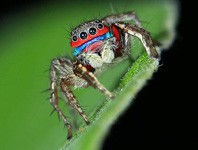Abstract
Leptobasis linda is described from the Pacific lowlands of Ecuador. The coloration of mature individuals is superficially similar to the widespread L. vacillans, but structural and color characteristics differentiate L. linda from all congeneric species. The male caudal appendages and the female posterior margin of the prothorax are unique among Leptobasis.
References
Alayo, D.P. (1968a) Las libélulas de Cuba (Insecta-Odonata). Torreia (Nueva Serie), 2 (Parte I: Texto), 1–102.
Alayo, D.P. (1968b) Las libélulas de Cuba (Insecta-Odonata). Torreia (Nueva Serie), 3 (Parte II: Láminas), 1–54.
Donnelly, T.W. (1967) The discovery of Chrysobasis in Central America, with the description of a new species (Odonata: Coenagrionidae). Florida Entomologist, 50 (1), 47–52.
http://dx.doi.org/10.2307/3493207Garrison, R.W. & von Ellenrieder, N. (2010) Redefinition of Leptobasis Selys with the synonymy of Chrysobasis Rácenis and description of L. mauffrayi sp. nov. from Peru (Odonata: Coenagrionidae). Zootaxa, 2438, 1–36.
Garrison, R.W., von Ellenrieder, N. & Louton, J.A. (2010) Damselfly Genera of the New World. The Johns Hopkins University Press, Baltimore, Maryland, 490 pp.
González-Soriano, E. (2002) Leptobasis melinogaster spec. nov., a new species from Mexico (Zygoptera: Coenagrionidae). Odonatologica, 31 (2), 181–185.
Rácenis, J. (1959) Zwei neue Gattungen und Arten der Familie Coenagrionidae (Odonata) aus Venezuela. Senckenberger Biologie, 40 (112), 55–61.
Riek, E.R. & Kukalová-Peck, J. (1984) A new interpretation of dragonfly wing venation based upon Early Upper Carboniferous fossils from Argentina (Insecta: Odonatoidea) and basic character states in pterygote wings. Canadian Journal of Zoology, 62 (6), 1150–1166.
http://dx.doi.org/10.1139/z84-166Selys-Longchamps, E. de. (1877) Synopsis des Agrionines, 5me légion: Agrion (suite et fin). Les genres Telebasis, Argiocnemis et Hemiphlebia. Bulletin de l'Académie royale de Belgique, (2) 43, 97–159 (1–65 reprint).

